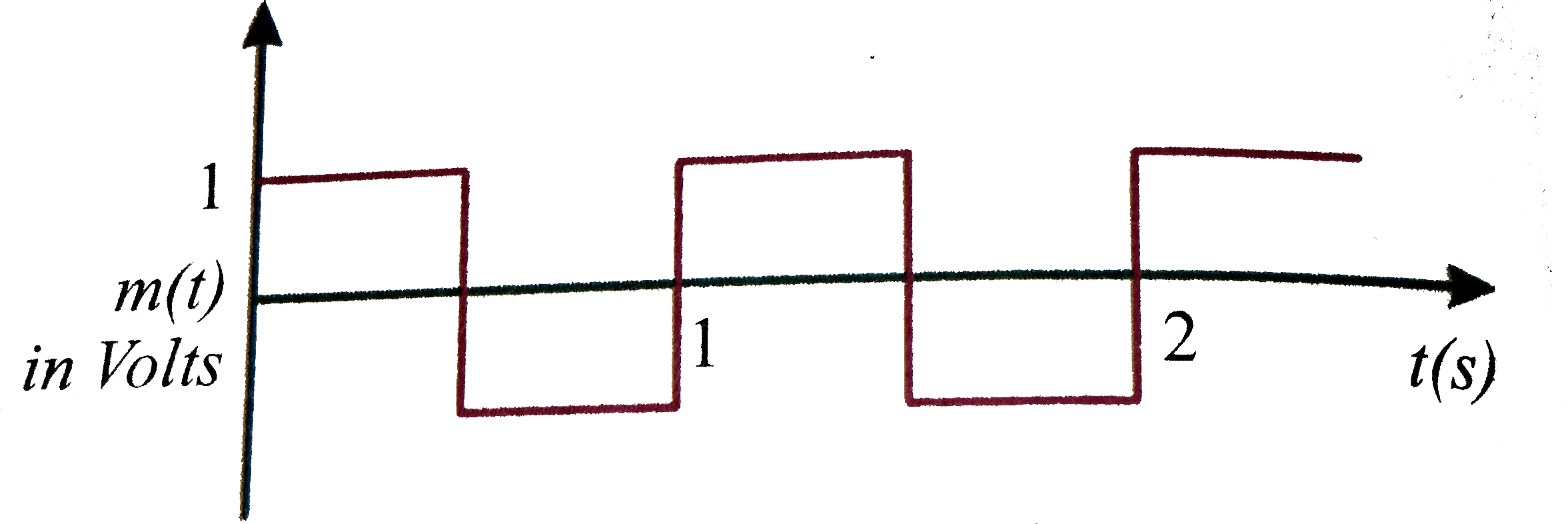The carrier wave is represented by
C(t)=5sin(10πt) volt
A modulating signal is a square wave as shown in figure. Determine modulation index.
To determine the modulation index for the given carrier wave and modulating signal, we can follow these steps:
Step 1: Identify the amplitude of the carrier wave
The carrier wave is given by the equation:
C(t)=5sin(10πt)
From this equation, we can see that the amplitude of the carrier wave AC is:
AC=5volts
Step 2: Identify the amplitude of the modulating signal
The modulating signal is a square wave. According to the problem, we need to determine its amplitude. For a square wave, the amplitude is defined as the peak value. From the provided information, we find that the amplitude of the modulating signal AM is:
AM=2volts
Step 3: Calculate the modulation index
The modulation index μ is defined as the ratio of the amplitude of the modulating signal to the amplitude of the carrier wave. Therefore, we can calculate the modulation index as follows:
μ=AMAC
Substituting the values we found:
μ=25
Step 4: Simplify the modulation index
Now, we simplify the fraction:
μ=0.4
Conclusion
Thus, the modulation index μ is:
μ=0.4
---
The carrier wave is given by the equation:
C(t)=5sin(10πt)
From this equation, we can see that the amplitude of the carrier wave AC is:
AC=5volts
The modulating signal is a square wave. According to the problem, we need to determine its amplitude. For a square wave, the amplitude is defined as the peak value. From the provided information, we find that the amplitude of the modulating signal AM is:
AM=2volts
The modulation index μ is defined as the ratio of the amplitude of the modulating signal to the amplitude of the carrier wave. Therefore, we can calculate the modulation index as follows:
μ=AMAC
Substituting the values we found:
μ=25
Now, we simplify the fraction:
μ=0.4
Thus, the modulation index μ is:
μ=0.4
Topper's Solved these Questions
- XII BOARDSBook:XII BOARD PREVIOUS YEAR PAPER ENGLISHChapter:XII BOARDSExercise:[SET - III, DELHI BOARD]
Explore 6 Videos
- XII BOARDSBook:XII BOARD PREVIOUS YEAR PAPER ENGLISHChapter:XII BOARDSExercise:section A
Explore 2 Videos
- XII BOARDSBook:XII BOARD PREVIOUS YEAR PAPER ENGLISHChapter:XII BOARDSExercise:[SET - I]
Explore 28 Videos
- SAMPLE PAPER 2019Book:XII BOARD PREVIOUS YEAR PAPER ENGLISHChapter:SAMPLE PAPER 2019Exercise:SECTION D
Explore 6 Videos
Similar Questions
The carrier wave of a signal is given by C(t) = 3sin(8πt)volt.
The modulating signal is a square wave as shown. Find its modulation index.
View SolutionIn an amplitude modulator circuit, the carrier wave is given by,
C(t)=4sin(20000πt) while modulating signal is given by, m(t)=2sin(2000πt). The values of modulation index and lower side band frequency are :
View Solution
Knowledge Check
A modulating signal is a square wave as shown in figure.

The carrier wave is given by
c(t)=2sin(8πt)volt.
The modulation index isA0.2B0.3C0.4D0.5A modulating signal is a square wave as shown in figure.

The carrier wave is given by
c(t)=2sin(8πt)volt.
The modulation index isA0.2B0.3C0.4D0.5A modulating signal is a square wave as shown in figure.

The carrier wave is given by
c(t)=2sin(8πt)volt.
The modulation index isA0.2B0.3C0.4D0.5
A modulating signal is a square wave as shown in figure.

The carrier wave is given by
c(t)=2sin(8πt)volt.
The modulation index is
View SolutionIf Am and Acare the amplitudes of modulating signal and carrier wave respectively, then modulation index is given by
View SolutionA 100 MHz xarrier wave frequency is modulated by 10 kHz sinusoidal modulating signal. If the maximum frequency deviation is 50 kHz, find the modulation index.
View SolutionA carrier wave of peak voltage 12V is used to transmit a message signal. The peak voltage of the modulating signal in order to have a modulation index of 75% is
View SolutionA carrier wave of peak voltage 12V is used to transmit a message signal. The peak voltage of the modulating signal in order to have a modulation index of 75% is
View Solution

